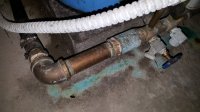Midnight
New Member
Hi all. I have a quick question, of course I might be back if I have trouble with this project. Here goes. What material is the incoming pipe from my submersible well? It is solid black, is 1 inch and has no markings. It feels like hard plastic. Is it pvc? I'm trying to replace the pressure tank along with the fixtures going to it, but I kind of needed to know what this pipe is made of. Thanks for any help.

